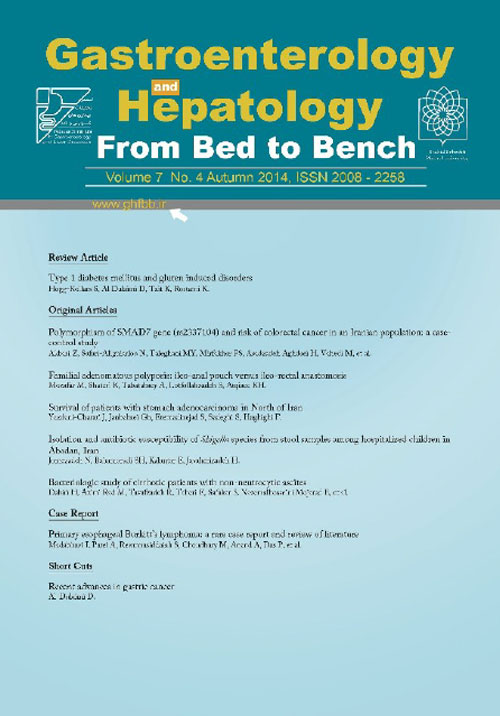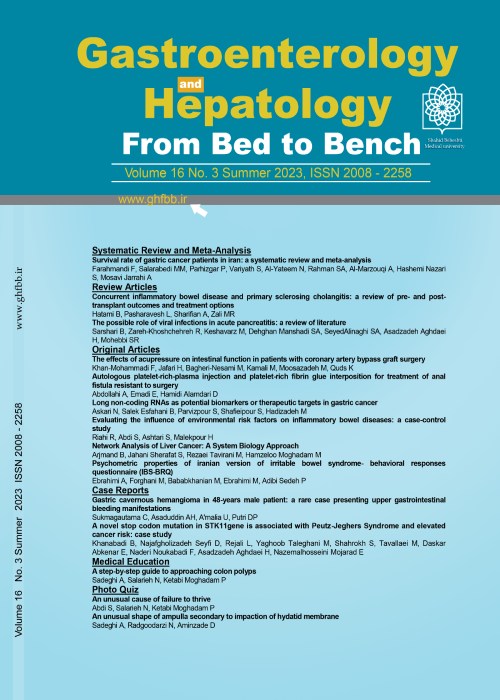فهرست مطالب

Gastroenterology and Hepatology From Bed to Bench Journal
Volume:7 Issue: 4, Autumn 2014
- تاریخ انتشار: 1393/07/05
- تعداد عناوین: 8
-
-
Page 189Over the last five decades the association between coeliac disease and other autoimmune disorders such as autoimmune thyroid disease or diabetes mellitus type 1 has been well established through many studies and to this day is subject to on-going clinical and scientific investigation worldwide. While no link has been established between celiac disease and type-2 diabetes mellitus, coeliac disease is common in patients with type 1 diabetes. The improvement of symptoms in patients with both conditions through dietary intervention, in the form of a gluten free diet, has been widely described within the literature. Our objectives were to review and synthesise the current knowledge on the nutritional treatment for patients with both conditions.Keywords: Coeliac disease_Genes_Gluten free diet_Malabsorption_Type 1 diabetes mellitus
-
Page 198AimThe purpose of this study was to evaluate the influence of intronic polymorphism of the SMAD7 (Mothers Against Decantaplegic Homolog 7) gene (rs2337104) on the risk of colorectal cancer (CRC) and clinicopathological features in an Iranian population.BackgroundSMAD7 has been identified as an antagonist of transforming growth factor beta (TGF-b)-mediating fibrosis, carcinogenesis, and inflammation. Regarding to the recent genome-wide scan, a risk locus for colorectal cancer at 18q21 has been found, which maps to the SMAD7 gene. Patients andMethodsThis case-control study was performed on 109 CRC patients and 109 healthy controls recruited in Taleghani Hospital. The genotyping of all samples were done by TaqMan assay via an ABI 7500 Real Time PCR System (Applied Biosystems) with DNA from peripheral blood. The association of this polymorphism with the risk of CRC and clinicopathological features was investigated.ResultsOur results indicated that there were no significant association between genotypic and allelic frequencies of SMAD7 polymorphism (rs2337104) and CRC risk in our population. Although the T allele is the most frequent one in this population and its frequency was 86.7% in patients compared with 91.7% in controls (OR=1.705, 95% CI= 0.916–3.172). Also, the SMAD7 genotypes were not associated with any clinicopathological\ characteristics in CRC patients (P>0.05).ConclusionFor the first time, this study results revealed that this SMAD7 polymorphism couldn’t be a potential risk factor for CRC or a prognostic biomarker for prediction of clinicopathological features in an Iranian population. A largescale case-control study is needed to validate our results.Keywords: SMAD7, Colorectal cancer, Single nucleotide polymorphism (SNP)
-
Page 206AimIn this study we describe the presentation, treatment, and complications of 27 FAP patients.BackgroundTreatment of Familial adenomatous polyposis (FAP) is centered on early recognition and curative surgery with either restorative proctocolectomy with ileal-pouch-anal-anastomosis (IPAA) or colectomy with ileo-rectal anastomosis (IRA). Patients andMethodsAll patients diagnosed with FAP at our center from 2008 to 2012 were included in this case series. Either IPAA or IRA was used for treatment. Complications were recorded for 12 months after the procedure.ResultsOverall 27 patients were included, 12 (44.44%) index patients, and 15 55.55%) relatives diagnosed by screening. Eight Index patients presented with rectal bleeding, two with occult fecal blood and two with abdominal masses found to be desmoid tumors. Nineteen patients were treated by IPAA, 6 with IRA, and 2 were inoperable due to diffuse desmoid tumors. Daytime stool frequency was the most common side effect 70.37%), followed by bowel discomfort episodes (55.56%), requiring dietary restrictions (37.4%), passive incontinence (25.93%), soiling (22.22%), nighttime stool frequency (18.52%), flatus incontinence (16.0%), and anastomosis leakage (3.70%). On average patients treated by IPAA experienced less complication than those treated by IRA.Conclusioncompared with previous reports, this series had older age of diagnosis, higher rate of adenocarcinoma at diagnosis, and fewer side effects after IPAA than IRA. The latter may reflect technique improvement with experience, and if supported by future studies, will cement IPAA as the treatment of choice in FAP.Keywords: Familial adenomatous polyposis (FAP), J, pouch, Proctocolectomy
-
Page 211AimThis study was proposed for estimation of survival time in patients with stomach adenocarcinoma.BackgroundNorth of Iran has a high mortality rate of stomach adenocarcinoma. Patients andMethodsThe study was historical cohort. The samples were the patients with stomach adenocarcinoma referred to Tooba Clinic between three years (2007-2010). Survival estimates were calculated using the Kaplan-Meier method the effects of covariates on survival time were assessed by, using survival parametric regression model with gamma frailty.ResultsThe survival probability of more than two years of patients was calculated 27.7% by using Kaplan Mayer method. The stage, metastasis, surgery, and age were the variables which affect the survival probability of patients, by using survival parametric regression model with gamma frailty and hazard ratio of patients with three treatment protocol was 0.43 times of others (P<0.01) and increasing of patients ages decrease life time of them significantly as per year increasing patient age, risk of death increased by 4% (P<0.04) and patients with staging disease lower 4 had hazard ratio lower than 0.46 times of stage 4 (P<0.01).ConclusionThe survival time of our patients is much lower than the developed countries, which are related to latency in diagnosis and therapeutic limitations.Keywords: Cox hazard proportional model, Life table, Parametric model, Stomach adenocarcinoma
-
Page 218AimThe aim of this study was to determine the incidence of Shigella species and their antimicrobial susceptibility patterns in hospitalized children with Shigellosis in Abadan, Iran.BackgroundShigellosis is caused by different species of Shigella and one of the most common causes of diarrhea in children. This disease is endemic in many developing countries including Iran. Patients andMethodsThis prospective cross sectional study was conducted in a teaching hospital in Abadan, Iran during June 2011 to May 2013. Stool specimens were collected from pediatric age group. All isolates were confirmed as Shigella species by biochemical and serologic tests. Antibiotic sensitivity pattern of these isolates was studied by disk diffusion Method.ResultsAmong all 705 stool samples, 36 (5.1%) yielded Shigella. Of cases, 392 (55.6%) were girl and 313 (44.4%) were boy. The most common Shigella isolates were S. flexneri (n=19, 52.7%) followed by S. sonnei (n=11, 30.5%), S. boydii (n=4, 11.1%) and S. dysenteriae 2(5.5%). Of the Shigella isolates, 47.2% showed resistance to two or more antimicrobial agents. Resistance pattern against various antimicrobials were as follows: trimethoprimsulphamethoxazole (80.5%), ampicillin (63.8%), tetracycline (58.3%), chloramphenicol (33.3%), nalidixic acid (27.7%), and cefixime (16.6%). There was no resistance against ciprofloxacin and ceftriaxone.ConclusionThe most common isolates were S. flexneri followed by S. Sonnei. There was no antibiotic resistance against ciprofloxacin and ceftriaxone. TMP-SMZ showed highest resistance pattern.Keywords: Antimicrobial resistance, Children, Shigella
-
Page 224AimWe aimed for detection of bacterial DNA (bactDNA) in spontaneous bacterial peritonitis (SBP) by polymerase chain reaction (PCR) and its prognostic relevance in cirrhotic patients with culture-negative non neutrocytic ascites (CNNNA).Backgroundapproximately 60% of patients with spontaneous bacterial peritonitis (SBP) are ascites culture negative. Patients andMethodsOf each 77 patients with cirrhosis and ascites, two samples including blood and ascitic fluid (AF) were taken. Blood samples were obtained for routine biochemical study and PMN count. AF samples were used for biochemical analysis and aerobic and anaerobic culture. BactDNA was detected by polymerase chain reaction (PCR) using bacterial universal 16srRNA gene primer.ResultsOf all AF samples, 3 (3.9%) were positive for bacterial culture (one streptococcus α hemolytic and two E.coli). The mean number of PMN in AF was 63. BactDNA was detected in 33 (42.9%) of 77 of samples (group A) and bactDNA was absent in 41 (53.2%) of samples (group B). Blood WBC, prothrombin time, LDH, serum total protein, AF WBC, serum albumin, AF albumin, AF total protein, serum total bilirubin, AST, ALT and BUN were not statically different among group A and B. Hepatitis B, 41(45%), was the most frequent cause of cirrhosis.ConclusionHepatitis B is the common cause of cirrhosis in Iranian cirrhotic patients. Also, current study showed that high number of Iranian cirrhotic patients with CNNNA carries bactDNA in their AF. The clinical findings as well as clinical laboratory data in patients with CNNNA are independent to bactDNA status in their ascitic fluid.Keywords: Ascitic fluid, BactDNA, Cirrhosis, Culture, negative non, neutrocytic ascites, Spontaneous bacterial peritonitis
-
Page 230Esophageal lymphoma is a rare condition, accounting for less than 1% of all gastrointestinal lymphomas. Primary extra nodal esophageal lymphoma constitutes less than 0.2% cases of the total esophageal lymphomas. The definition of primary GI lymphoma has differed among authors. The etiology of the disease is unknown, with the role of Epstein-Barr virus being controversial. The common symptoms of patients with esophageal lymphoma include dysphasia, odynophagia, weight loss, chest pain or present as a result of complications. Burkitt’s lymphoma is one of thefastest growing human malignancies, with a 100% replication rate. Endemic, sporadic (non-endemic) and immunodeficient variants have been recognized. The diagnosis of Burkitt’s lymphoma relies on morphologic findings, immunophenotyping results, and cytogenetic features. Burkitt’s lymphoma is usually treated with LMB-96 protocol depending on the risk stratification. We present a case of primary esophageal Burkitt’s lymphoma, which has been successfully treated with LMB-96 protocol. An extensive review of literature did not reveal a single case of esophageal Burkitt’s lymphoma. To the best of our knowledge this is the first case report in the world literature with diagnosis of primary esophageal Burkitt’s lymphoma.Keywords: Gastrointestinal (GI) lymphoma, Non, Hodgkin's Lymphoma (NHL), Burkitt's lymphoma (BL), Diffuse large B, cell lymphoma (DLBCL), COPADM
-
Page 238


